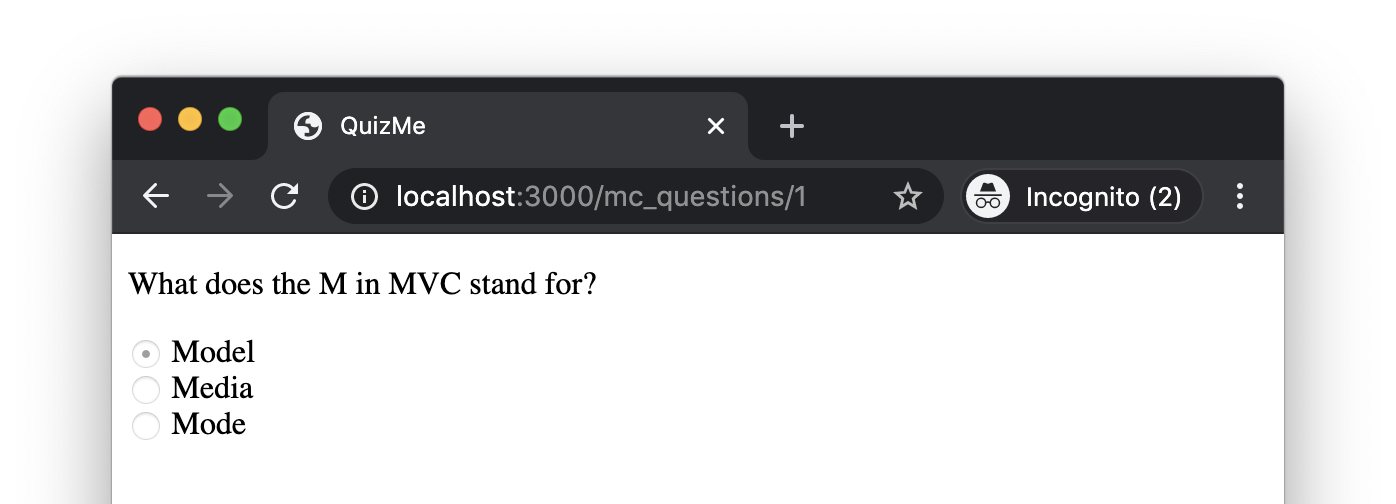Displaying a Single Model Record
In this demonstration, I will show how to create a so-called show page that displays one specific model record on a webpage. We will continue to build upon the QuizMe project from the previous demos.
In particular, we will add a show page to the QuizMe app that displays a McQuestion record stored in the database, as depicted in Figure 1.

Figure 1. The show page for a McQuestion record.
Adding this show page will involve several key steps:
- Adding a
showroute forMcQuestionrecords that translates HTTP requests for theshowpage into invocations of the appropriate controller action. - Adding a
showcontroller action to theMcQuestionsControllerclass created last demo that, when invoked, will retrieve the appropriateMcQuestionrecord from the database and will render the appropriate view, passing in the retrieved record for the view to display. - Adding a
showview forMcQuestionrecords that will render a webpage containing whateverMcQuestionrecord is passed to the view.
1. Adding a show Route for McQuestion Records
In routes.rb, insert after the index route a standard resource route for the show action of the McQuestionsController class, like this:
get 'mc_questions/:id', to: 'mc_questions#show', as: 'mc_question' # show
In a previous demo, we passed user data (i.e., parameters) from a webpage to the Rails server via POST requests (recall the params hash); however, parameters can also be passed via GET requests. One such way is illustrated in the above show route. In particular, this show route’s URI pattern includes an :id request parameter that becomes part of the URL (e.g., http://localhost:3000/mc_questions/125). When the Rails web server receives a GET request that matches that show route, the invoked controller action can retrieve the :id value (e.g., 125) via the params hash—specifically, using params[:id].
2. Adding a show Controller Action for McQuestion Records
In this part, we will add a show action to the McQuestionsController class. This is the “to:” action specified in the above show route and will be called whenever an incoming HTTP request matches that route.
To begin with, add the show action, including a respond_to block, like we’ve seen in previous demos:
def show
respond_to do |format|
format.html { render :show }
end
end
Similar to the index action, this one will also need to do some retrieving of model objects; however, in the case of the show action, we will just be retrieving one model object based on the id in the request URL.
Retrieve the appropriate McQuestion record by inserting this line before the respond_to block in the show action:
question = McQuestion.find(params[:id])
The find method is yet another model method provided by Rails. In the above usage, it retrieves the saved McQuestion record with the specified id.
Once the McQuestion object have been retrieved, it will need to be passed to the view for rendering.
Similar to the last demo, we will add the locals hash as an argument to the call to render to pass the retrieved McQuestion object to the view, like this:
format.html { render :show, locals: { question: question } }
Note! In the index action, we had multiple McQuestion records, so we used the variable name questions (plural); however, in the show action, we have only one McQuestion record, so we use the variable name question (singular).
3. Adding a show View for McQuestion Records
The show action should display all the important attributes of the mc_question object (i.e., not the timestamps and not the id, because that is shown in the URL). Similar to the index view, we will display the question text followed by a radio button with the answer choices, as depicted in Figure 1.
To start with, create a file app/views/mc_questions/show.html.erb for the view.
Display the question text by inserting a <p> block for the question text at the top of view, like this:
<p><%= question.question %></p>
Display answer choices as a radio button (using similar code to that which was used in the index view) by inserting this code after the question text:
<% choices = [question.answer, question.distractor_1, question.distractor_2] %>
<% choices.each do |c| %>
<div>
<%= radio_button_tag "guess", c, checked = c == question.answer, disabled: true %>
<%= label_tag "guess_#{c}", c %>
</div>
<% end %>
The QuizMe app now provides pages for displaying individual multiple-choice questions (show pages). For example, opening the URL http://localhost:3000/mc_questions/1 should display a page like the on depicted in Figure 1. Similarly, the URLs http://localhost:3000/mc_questions/2 and http://localhost:3000/mc_questions/3 should display show pages for the other two questions in the database. Clearly, it isn’t very convenient entering URLs manually to show these records, and in future demos, we will add hyperlinks to make navigating to these pages more convenient.
The QuizMe app now has index and show pages that cover the R (“Read”) functionality in CRUD. In upcoming demos, we will add C (“Create”), U (“Update”), and D (“Delete”) functionality to complete the app’s CRUD capabilities.